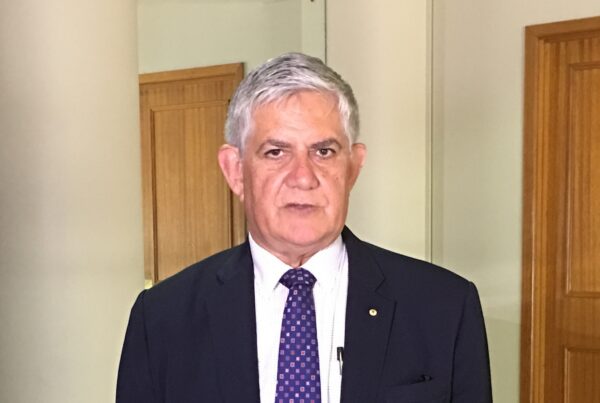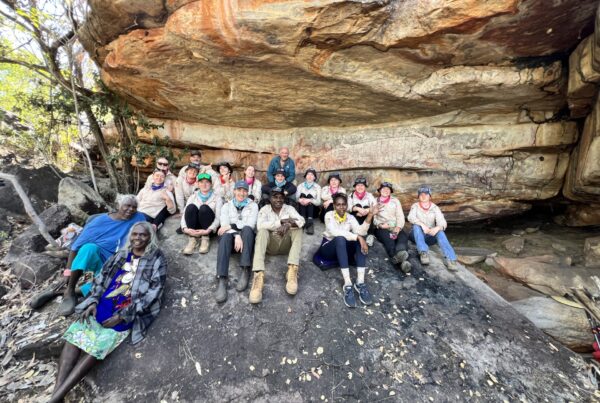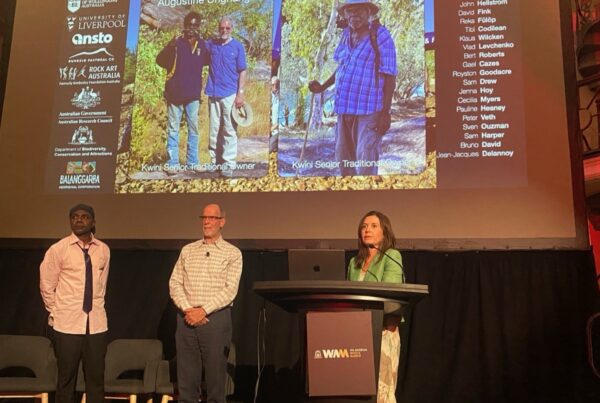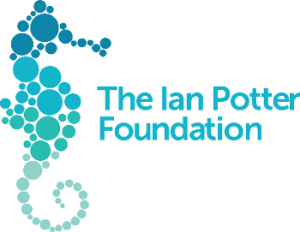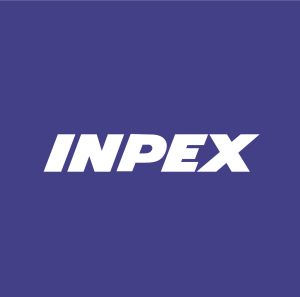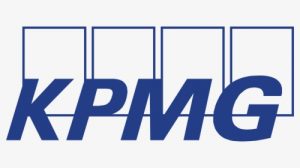Header image: Dr Helen Green, centre, with PhD student Faris Ruzain, and Masters student Marina Mitsopolous to the left, and Jess Masson, East Kimberley College, and SAC member and University of Sydney archaeologist Tristen Jones to the right
Inspiring the Next Generation & Championing Two-Way Science, Cultural Leadership, and Community-Driven Research
RAA: You’ve described the experience of when you joined the rock art dating team and went on your first field trip on Balanggarra Country as life-changing and a turning point in your career. What changed for you at that moment, and how did it shape your purpose going forward?
Helen: So many aspects of the rock art dating team have had a lasting impact on both my career and my life. I’m originally from England and had visited Australia several times as a child to see family when I joined the project, but I knew very little about Australia’s deep history or Indigenous cultures. I had never been to the Kimberley. I had never been camping! That first field trip was a steep learning curve, but also an unforgettable experience. Surrounded by breathtaking landscapes, extraordinary cultural sites, and people whose lives and perspectives were so different from my own, I found it incredibly eye-opening in the best possible way.
The sense of camaraderie in those field camps, and the shared feeling that we were incredibly fortunate to be there, created a strong foundation for both professional collaboration and genuine connection. Coming back year after year to such a remarkable place, and working alongside such dedicated people, from all walks of life, built not only solid working relationships but also friendships I hope I will have for life.
RAA: The Rock Art Dating Project has often been described as an “academy for the next generation.” What do you think made it such a conducive environment for learning and leadership?
Helen: The project was led by Professor Andy Gleadow, whose exemplary leadership showed us that successful research is built on long-term relationships grounded in mutual respect and a commitment to championing others. It also brought together many other leading figures in the field such as Professor Bruno David and Professor Jean-Jacques Delannoy whose dedication, meticulous attention to detail, and inclusive approach to team building and research development were inspiring. There were also outstanding communicators like Professors Peter Veth and Bert Roberts, whose enthusiasm made complex ideas accessible and engaging. And then there were passionate, independent rock art researchers like Cecilia Myers, Pauline Heaney, Nick Sundblom, Sue Ball, Pete Townsend, and Joc Schémichen, who have devoted much of their lives to work in the Kimberley, showing us all what it means to truly follow a passion. Kalumburu community members like the Waina and Unghango families taught us about Indigenous culture, friendship and resilience and our camp manager Paul Hartley gave us a master class in patience and calm leadership. Finally, I was fortunate to be part of a cohort of new energetic researchers like Dr Reka Fulop, Dr Sam Harper and Dr Damien Finch who had the opportunity to learn directly from all these people, while also learning from and supporting one another along the way.
RAA: Why is it so important to continue investing in collaborative science research in Australia, especially projects that bring together researchers, Traditional Owners, and young people to work on shared goals like protecting cultural heritage?
Helen: Collaborative research is the only way to do Archaeological Science research in Australia. This approach offers huge benefits to all involved, fostering mutual respect, knowledge exchange, and cultural preservation. These partnerships ensure that research projects are guided by Indigenous perspectives, leading to more accurate interpretations of cultural heritage and history. Traditional Owners bring invaluable ancestral knowledge and deep connections to the land, enriching our western scientific understanding with context that might otherwise be overlooked. Such collaboration also empowers Indigenous communities by giving them a central role in managing and protecting their heritage, promoting ethical research practices and long-term stewardship of cultural sites.
RAA: You’ve recently returned from the first trip to the Kimberley for the outreach project. What were some of the highlights, and what do you hope the young people involved take away from it?
Helen: An unexpected highlight for me was spending time with the outreach team in Kununurra; Dr Tristen Jones, Marina Mitsopoulos, Faris Ruzain and BAC Young Ranger Coordinator Amos Smith. We all worked hard together to develop an exciting and interesting program and getting to know each other better, in a Kimberley setting, was a great experience.
Another real highlight was seeing the energy and enthusiasm from the Year 9 students at East Kimberley College increase throughout the day as they engaged with hands-on activities like archaeological site recording, geology basics, rock art conservation, and fire management, delivered in partnership with the Balanggarra Young Rangers Amos Smith and Creshaune Carter. The students worked in teams to answer questions for rock themed prizes and gained confidence throughout the day. A particularly powerful moment was the two-way learning approach to cultural heritage management-where Marina demonstrated how fire impacts rock art pigments at a physiochemical level, while the Rangers shared their traditional knowledge of fire and land management. The day not only sparked curiosity and pride among the students but also provided valuable science communication experience for our university team and opened exciting conversations about future pathways for students. I hope the Year 9s came away with a new interest in science and archaeology, and the confidence that their voices and knowledge are vital to shaping the future of this research.
RAA: For those considering supporting Rock Art Australia, whether as a donor, partner, or policymaker, what would you say to them about the importance of investing in science that connects culture, community, and Country?
Helen: Supporting respectful partnerships with Traditional Owners, empowering communities, and contributing to a more inclusive and accurate understanding of Australia’s past is an investment in both world-class research and the enduring cultural legacy of Aboriginal and Torres Strait Islander peoples.
Recently funded projects such as the School Outreach and the Kalumburu women’s cultural education engagement project provide opportunities for partnership and collaboration between cultural and scientific educators, enabling both local and visiting students to connect Indigenous Knowledge alongside Scientific knowledge, at the same time. They then bring this learning to their respective schools, where it is further built upon by elders and educators in their home communities. So it is not only about investing in science, but also connecting the science outcomes with tangible community outcomes, in a way that all stakeholders and partners have found to be valuable.
RAA: Looking to the future, what’s your vision for the next generation of scientists? What advice would you give your younger self?
Helen: We have many outstanding students progressing through the Archaeological Science group at the University of Melbourne. Not only are they dedicated researchers advancing the field, but they are also committed to ensuring their work delivers meaningful benefits to the wider community. They actively seek opportunities to communicate their research in ways that are relevant and useful to partners beyond the university. I always encourage them to embrace these opportunities-we are so lucky that our research is inherently multi-faceted, extending well beyond the lab or academic conferences. Engaging with communities and research partners provides essential context, deepening our understanding of the work we do and why we do it!
The inaugural School Outreach Program at East Kimberley College
On August 11th, Rock Art Australia funded the inaugural school outreach program at East Kimberley College, led and coordinated by Dr Helen Green, in collaboration with SAC member and University of Sydney archaeologist Tristen Jones, Master’s student Marina Mitsopoulos, and PhD student Faris Ruzain-both researching rock art in the context of dating and conservation. Delivered in partnership with the Balanggarra Young Rangers Amos Smith and Creshaune Carter, the full-day workshop engaged Year 9 students through a series of hands-on activities including archaeological site recording, geology basics, conservation challenges for rock art, and ranger-led fire management. A key highlight was the two-way learning approach to cultural heritage management, with Marina demonstrating the physio-chemical impacts of fire on cultural pigments, while the Rangers shared their traditional fire knowledge and land management strategies.
The program was extremely well received by students and teachers, who expressed a strong interest in hosting it again next year. It also created meaningful opportunities to connect with the broader community, while providing a platform for university students to build their science communication and outreach skills.
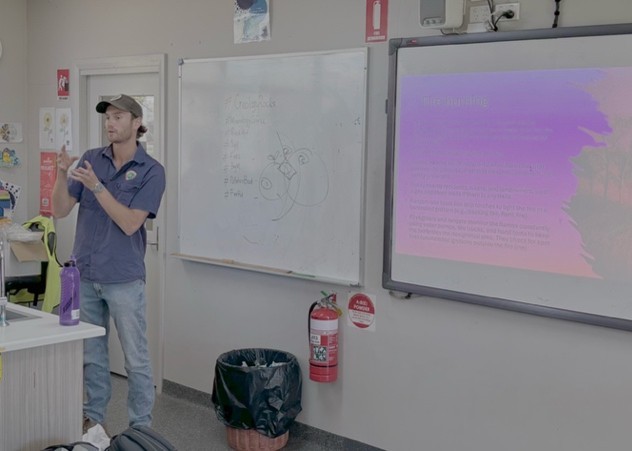
BAC Young Ranger Coordinator Amos Smith presenting about fire management
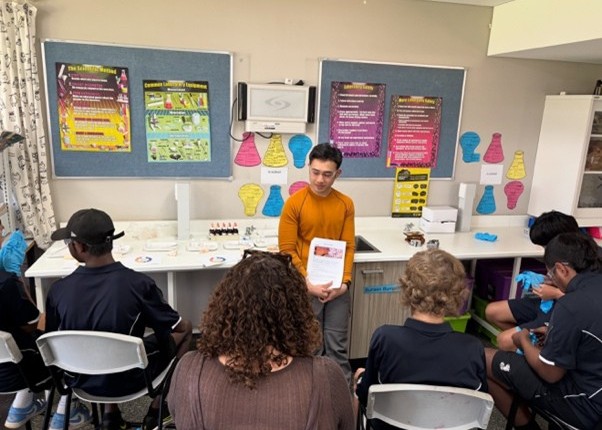
Faris Ruzain demonstrating an experiment with EKC students
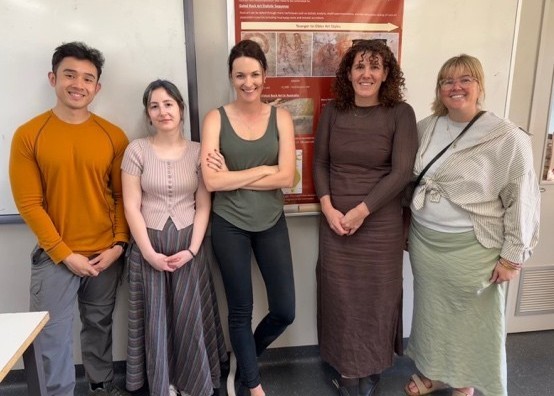
Faris Ruzain, Marina Mitsopolous, Helen Green, Jess Masson (EKC) and Dr Tristen Jones


